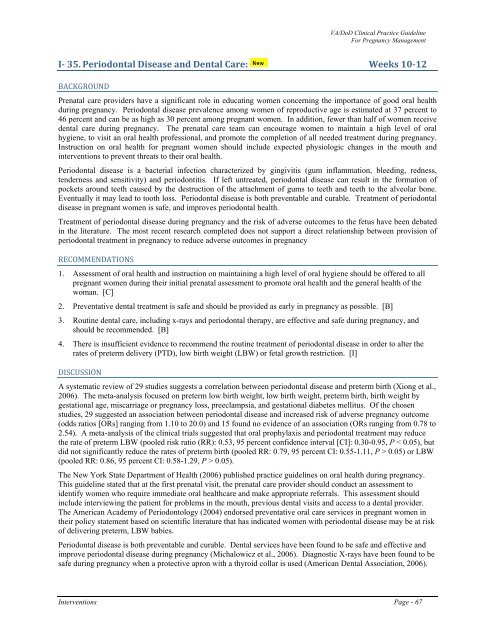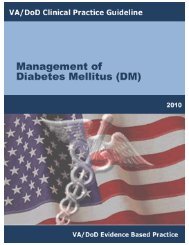Management of pregnancy - VA/DoD Clinical Practice Guidelines ...
Management of pregnancy - VA/DoD Clinical Practice Guidelines ...
Management of pregnancy - VA/DoD Clinical Practice Guidelines ...
Create successful ePaper yourself
Turn your PDF publications into a flip-book with our unique Google optimized e-Paper software.
<strong>VA</strong>/<strong>DoD</strong> <strong>Clinical</strong> <strong>Practice</strong> Guideline<br />
For Pregnancy <strong>Management</strong><br />
I 35. Periodontal Disease and Dental Care: Weeks 1012<br />
BACKGROUND<br />
Prenatal care providers have a significant role in educating women concerning the importance <strong>of</strong> good oral health<br />
during <strong>pregnancy</strong>. Periodontal disease prevalence among women <strong>of</strong> reproductive age is estimated at 37 percent to<br />
46 percent and can be as high as 30 percent among pregnant women. In addition, fewer than half <strong>of</strong> women receive<br />
dental care during <strong>pregnancy</strong>. The prenatal care team can encourage women to maintain a high level <strong>of</strong> oral<br />
hygiene, to visit an oral health pr<strong>of</strong>essional, and promote the completion <strong>of</strong> all needed treatment during <strong>pregnancy</strong>.<br />
Instruction on oral health for pregnant women should include expected physiologic changes in the mouth and<br />
interventions to prevent threats to their oral health.<br />
Periodontal disease is a bacterial infection characterized by gingivitis (gum inflammation, bleeding, redness,<br />
tenderness and sensitivity) and periodontitis. If left untreated, periodontal disease can result in the formation <strong>of</strong><br />
pockets around teeth caused by the destruction <strong>of</strong> the attachment <strong>of</strong> gums to teeth and teeth to the alveolar bone.<br />
Eventually it may lead to tooth loss. Periodontal disease is both preventable and curable. Treatment <strong>of</strong> periodontal<br />
disease in pregnant women is safe, and improves periodontal health.<br />
Treatment <strong>of</strong> periodontal disease during <strong>pregnancy</strong> and the risk <strong>of</strong> adverse outcomes to the fetus have been debated<br />
in the literature. The most recent research completed does not support a direct relationship between provision <strong>of</strong><br />
periodontal treatment in <strong>pregnancy</strong> to reduce adverse outcomes in <strong>pregnancy</strong><br />
RECOMMENDATIONS<br />
1. Assessment <strong>of</strong> oral health and instruction on maintaining a high level <strong>of</strong> oral hygiene should be <strong>of</strong>fered to all<br />
pregnant women during their initial prenatal assessment to promote oral health and the general health <strong>of</strong> the<br />
woman. [C]<br />
2. Preventative dental treatment is safe and should be provided as early in <strong>pregnancy</strong> as possible. [B]<br />
3.<br />
4.<br />
Routine dental care, including x-rays and periodontal therapy, are effective and safe during <strong>pregnancy</strong>, and<br />
should be recommended. [B]<br />
There is insufficient evidence to recommend the routine treatment <strong>of</strong> periodontal disease in order to alter the<br />
rates <strong>of</strong> preterm delivery (PTD), low birth weight (LBW) or fetal growth restriction. [I]<br />
DISCUSSION<br />
A systematic review <strong>of</strong> 29 studies suggests a correlation between periodontal disease and preterm birth (Xiong et al.,<br />
2006). The meta-analysis focused on preterm low birth weight, low birth weight, preterm birth, birth weight by<br />
gestational age, miscarriage or <strong>pregnancy</strong> loss, preeclampsia, and gestational diabetes mellitus. Of the chosen<br />
studies, 29 suggested an association between periodontal disease and increased risk <strong>of</strong> adverse <strong>pregnancy</strong> outcome<br />
(odds ratios [ORs] ranging from 1.10 to 20.0) and 15 found no evidence <strong>of</strong> an association (ORs ranging from 0.78 to<br />
2.54). A meta-analysis <strong>of</strong> the clinical trials suggested that oral prophylaxis and periodontal treatment may reduce<br />
the rate <strong>of</strong> preterm LBW (pooled risk ratio (RR): 0.53, 95 percent confidence interval [CI]: 0.30-0.95, P < 0.05), but<br />
did not significantly reduce the rates <strong>of</strong> preterm birth (pooled RR: 0.79, 95 percent CI: 0.55-1.11, P > 0.05) or LBW<br />
(pooled RR: 0.86, 95 percent CI: 0.58-1.29, P > 0.05).<br />
The New York State Department <strong>of</strong> Health (2006) published practice guidelines on oral health during <strong>pregnancy</strong>.<br />
This guideline stated that at the first prenatal visit, the prenatal care provider should conduct an assessment to<br />
identify women who require immediate oral healthcare and make appropriate referrals. This assessment should<br />
include interviewing the patient for problems in the mouth, previous dental visits and access to a dental provider.<br />
The American Academy <strong>of</strong> Periodontology (2004) endorsed preventative oral care services in pregnant women in<br />
their policy statement based on scientific literature that has indicated women with periodontal disease may be at risk<br />
<strong>of</strong> delivering preterm, LBW babies.<br />
Periodontal disease is both preventable and curable. Dental services have been found to be safe and effective and<br />
improve periodontal disease during <strong>pregnancy</strong> (Michalowicz et al., 2006). Diagnostic X-rays have been found to be<br />
safe during <strong>pregnancy</strong> when a protective apron with a thyroid collar is used (American Dental Association, 2006).<br />
Interventions Page - 67
















